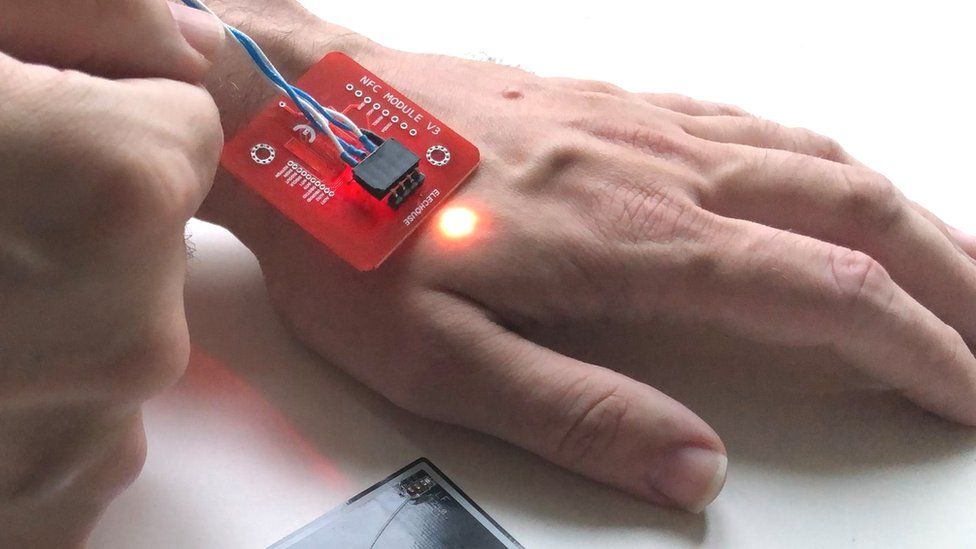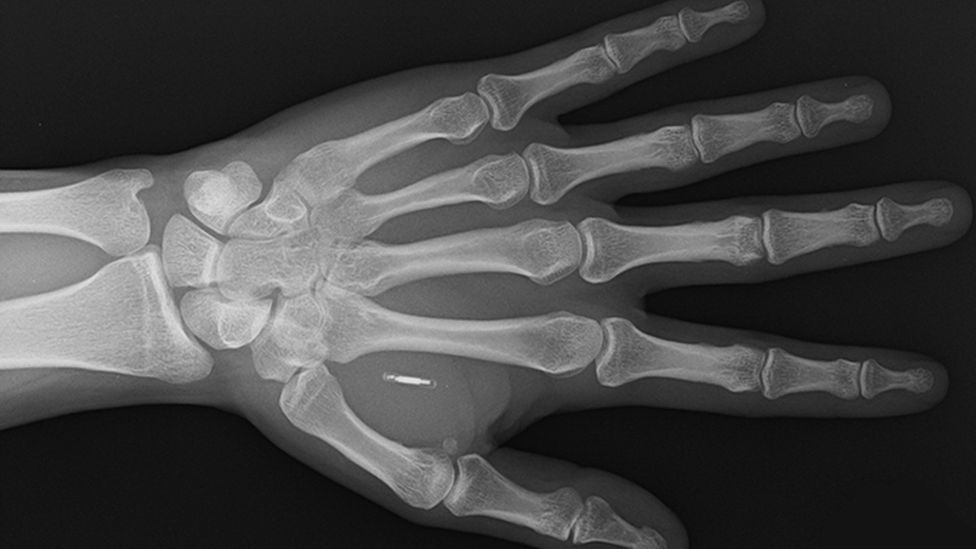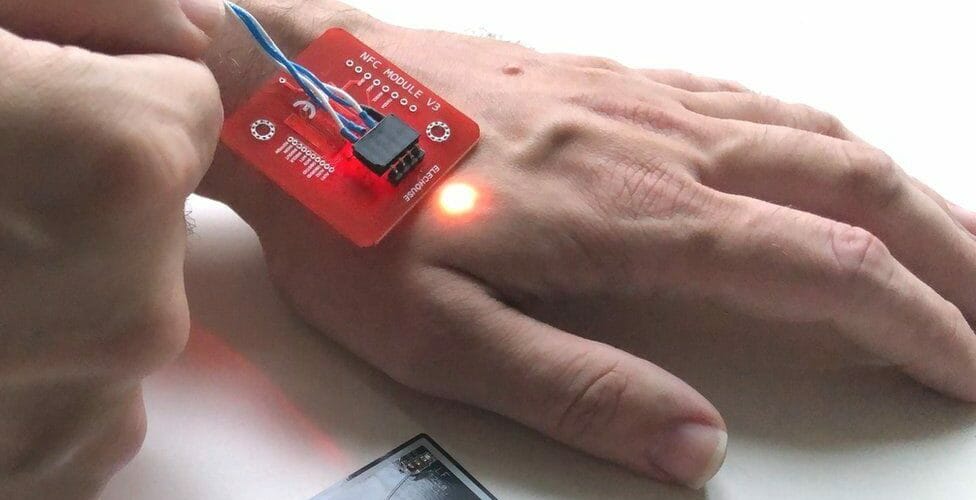The following report is from the BBC:
Patrick Paumen causes a stir whenever he pays for something in a shop or restaurant.
This is because the 37-year-old doesn’t need to use a bank card or his mobile phone to pay. Instead, he simply places his left hand near the contactless card reader, and the payment goes through.
The reactions I get from cashiers are priceless!
Says Mr Paumen, a security guard from the Netherlands.
He is able to pay using his hand because back in 2019 he had a contactless payment microchip injected under his skin.
The procedure hurts as much as when someone pinches your skin.
Says Mr Paumen

A microchip was first implanted into a human back in 1998, but it is only during the past decade that the technology has been available commercially.
And when it comes to implantable payment chips, British-Polish firm, Walletmor, says that last year it became the first company to offer them for sale.
The implant can be used to pay for a drink on the beach in Rio, a coffee in New York, a haircut in Paris – or at your local grocery store. It can be used wherever contactless payments are accepted.
Says founder and chief executive Wojtek Paprota.
Walletmor’s chip, which weighs less than a gram and is little bigger than a grain of rice, is comprised of a tiny microchip and an antenna encased in a biopolymer – a naturally sourced material, similar to plastic.
Mr Paprota adds that it is entirely safe, has regulatory approval, works immediately after being implanted, and will stay firmly in place. It also does not require a battery, or other power source. The firm says it has now sold more than 500 of the chips.
The technology Walletmor uses is near-field communication or NFC, the contactless payment system in smartphones. Other payment implants are based on radio-frequency identification (RFID), which is the similar technology typically found in physical contactless debit and credit cards.

For many of us, the idea of having such a chip implanted in our body is an appalling one, but a 2021 survey of more than 4,000 people across the UK and the European Union found that 51% would consider it.
However, without giving a percentage figure, the report added that “invasiveness and security issues remained a major concern” for respondents.
Mr Paumen says he doesn’t have any of these worries.
Chip implants contain the same kind of technology that people use on a daily basis. From key fobs to unlock doors, public transit cards like the London Oyster card, or bank cards with contactless payment function.
The reading distance is limited by the small antenna coil inside the implant. The implant needs to be within the electromagnetic field of a compatible RFID [or NFC] reader. Only when there is a magnetic coupling between the reader and the transponder can the implant can be read.
He says
He adds that he is not concerned that his whereabouts could be tracked.
RFID chips are used in pets to identify them when they’re lost. But it’s not possible to locate them using an RFID chip implant – the missing pet needs to be found physically. Then the entire body gets scanned until the RFID chip implant is found and read.
He says.
Yet the issue with such chips, (and what causes concern), is whether in the future they become ever more advanced, and packed full of a person’s private data. And, in turn, whether this information is secure, and if a person could indeed be tracked.
Financial technology or fintech, expert Theodora Lau, is co-author of the book Beyond Good: How Technology Is Leading A Business Driven Revolution.
She says that implanted payment chips are just “an extension of the internet of things”. By that she means another new way of connecting and exchanging data.
Yet, while she says that many people are open to the idea – as it would make paying for things quicker and easier – the benefit must be weighed up with the risks. Especially as and when embedded chips carry more of our personal information.
How much are we willing to pay, for the sake of convenience?Where do we draw the line when it comes to privacy and security? Who will be protecting the critical infrastructure, and the humans that are part of it?
She says.
Nada Kakabadse, professor of policy, governance and ethics at Reading University’s Henley Business School, is also cautious about the future of more advanced embedded chips.
There is a dark side to the technology that has a potential for abuse. To those with no love of individual freedom, it opens up seductive new vistas for control, manipulation and oppression.
And who owns the data? Who has access to the data? And, is it ethical to chip people like we do pets?
she says.
The result, she cautions, could be “the disempowerment of many for the benefits of a few”.
Steven Northam, senior lecturer in innovation and entrepreneurship at the University of Winchester, says that the concerns are unwarranted. In addition to his academic work he is the founder of UK firm BioTeq, which has been making implanted, contactless chips since 2017.
Its implants are aimed at people with disabilities who can use the chips to automatically open doors.
We have daily enquiries. And have carried out over 500 implants in the UK – but Covid caused some reduction in this.
This technology has been used in animals for years. They are very small, inert objects. There are no risks.
He says

Back in the Netherlands, Mr Paumen describes himself as a “biohacker” – someone who puts pieces of technology into his body to try to improve his performance. He has 32 implants in total, including chips to open doors and imbedded magnets.
Technology keeps evolving, so I keep collecting more. My implants augment my body. I wouldn’t want to live without them.
There will always be people who don’t want to modify their body. We should respect that – and they should respect us as biohackers.
He says
Survey Reveals That Americans Are Ready To Be Chipped And Install Cybernetic Implants In Them
AUTHOR COMMENTARY
[16] And he causeth all, both small and great, rich and poor, free and bond, to receive a mark in their right hand, or in their foreheads: [17] And that no man might buy or sell, save he that had the mark, or the name of the beast, or the number of his name. [18] Here is wisdom. Let him that hath understanding count the number of the beast: for it is the number of a man; and his number is Six hundred threescore and six.Revelation 13:16-18
They are just flying the mark of the beast technologies in our faces at increasing rates, as the masses are be primed to accept it. But that will come later. Right now, the current move is to further increase people’s dependency on their smart phones, by implementing QR codes everywhere; in tandem with vaccine passports, carbon calculators, central bank digital currencies, and food/energy IDs.
[7] Who goeth a warfare any time at his own charges? who planteth a vineyard, and eateth not of the fruit thereof? or who feedeth a flock, and eateth not of the milk of the flock? [8] Say I these things as a man? or saith not the law the same also? [9] For it is written in the law of Moses, Thou shalt not muzzle the mouth of the ox that treadeth out the corn. Doth God take care for oxen? [10] Or saith he it altogether for our sakes? For our sakes, no doubt, this is written: that he that ploweth should plow in hope; and that he that thresheth in hope should be partaker of his hope. (1 Corinthians 9:7-10).
The WinePress needs your support! If God has laid it on your heart to want to contribute, please prayerfully consider donating to this ministry. If you cannot gift a monetary donation, then please donate your fervent prayers to keep this ministry going! Thank you and may God bless you.









I wonder if and how long it’ll take for him to develop tumors where all those implants are (similar to pet microchipping)?